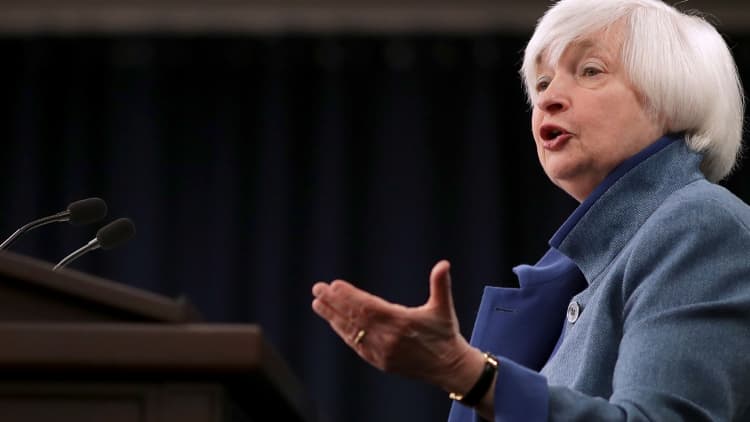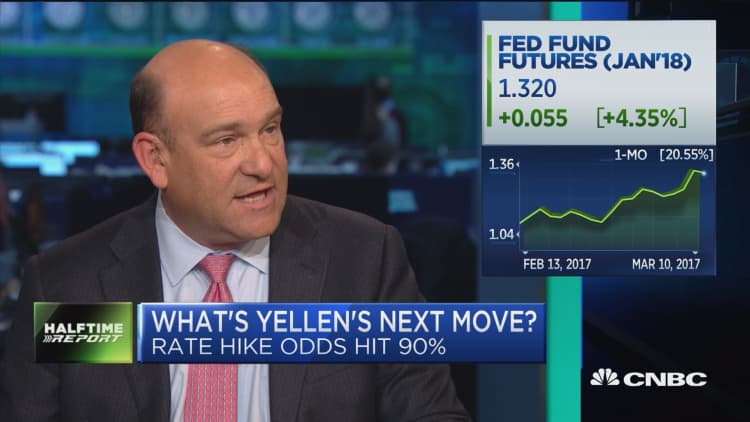
By now, everyone knows the Fed wants to hike interest rates Wednesday, but what is not known is what central bank officials think about future rate increases this year.
Friday's strong jobs report was the whipped topping on a parfait of strong indicators for the Fed. In the coming week, February retail sales and the consumer price index will both be important, but the Fed already has above-trend job growth of roughly 235,000 in both January and February, and hourly wage gains of a respectable 2.8 percent.
The Fed is expected to raise the fed funds target range by a quarter point, which would put it between 75 basis points and 1 percent. That move would directly impact short-term borrowing costs, but the Fed's rate moves are like a domino effect and will send even longer-term rates higher. Those rates affect everything from car loans to mortgages, and commercial loans.
When the central bank unfurls it's new forecasts Wednesday, the market will be looking to see if there's an adjustment in its collective interest rate outlook, which now points to three quarter-point rate hikes this year. The market has looked skeptically at these forecasts since the Fed began 2016 with forecasts pointing to four hikes, and ended the year with just one rate rise in December.
But in recent weeks, Fed officials mobilized a campaign to tell the markets it's time to hike and they could move in March, while expectations were for a June rate increase and then possibly one other this year. The market got on board with a March hike and is warming up to three increases for 2017.
Now, with the Fed seeing fresh labor market strength and signs of inflation picking up, officials may feel even more confident about moving forward with the hiking cycle.
"I think the risk of four rate hikes went up dramatically," said Diane Swonk, CEO of DS Economics, after Friday's strong February jobs report. Hiring was broad-based and the biggest sector was construction with 58,000 new jobs. But even with the strong hiring, GDP in the first quarter looks sluggish, forecast at under 2 percent.
"It's been the quantity of jobs, outpacing the quality of jobs. We're now seeing some jobs come about in manufacturing and construction. It looks like GDP has some issues with seasonality in the first quarter. That has been an ongoing issue. It's the volume of jobs versus over overall job growth. Now we're finally seeing some good jobs come back in manufacturing and construction ... we're finally getting wage acceleration and that's what the Fed wants to see," said Swonk.
Fed officials will provide new economic forecasts and their "dot plot," which is their individual interest rate forecasts, anonymously plotted on a chart. That currently shows expectations for three hikes this year.
"I think the odds have to favor more dots, favoring more rate hikes, rather than fewer," said Marc Chandler, global head of currency strategy at Brown Brothers Harriman. Chandler said the dollar could weaken early in the week due to technical selling, but the Fed may spark gains. "Maybe it's going to be a hawkish hike finally."
"I think the market is underestimating the hawkishness of the regional Fed presidents," said Chandler. "Why shouldn't the Fed raise rates once a quarter this year. ... With the employment number and the other readings on the economy, the economy is not fragile. Some of the words they've used are more confident on the economy."
Bank of America Merrill Lynch equity strategist Dan Suzuki said the stock market can tolerate the idea of one or two more Fed rate hikes.
"In the near term, the commentary and the dot plot could drive a short-term movement in the market, but I wouldn't think it's going to be the spark of a long lasting sell-off in the market, given the macro backdrop is very supportive. But that doesn't mean you couldn't get a 1 percent down move on the day, if [Fed Chair Janet Yellen] sounds more hawkish or the dot plot comes in more hawkish than the market is expecting," he said.
Stocks were lower in the past week, with the S&P 500 off 0.4 percent for the week at 2,372. The Dow was down a half percent at 20,902. U.S. oil prices fell sharply, dropping under $50 per barrel for the first time since Dec. 7.
West Texas Intermediate futures for April were off about 9 percent for the week, after a big jump in U.S. weekly supply. Officials from OPEC nations and Russia, at the CERAWeek by IHS Markit energy conference in Houston this past week, said it was premature to say whether they would extend their production deal in May.
That contributed to the slide, since it was that agreement that had been holding oil in the $50s per barrel since December. WTI futures for April settled at $48.49 per barrel Friday.
"It's a bearish signal" that WTI futures ended the week below $50, said John Kilduff of Again Capital. "The long speculators just bailed out left and right, and the technicals look bad." He said there's a chance WTI could fall into the low $40s.
Suzuki said the stock market, for now, should be able to take the decline in crude in stride. "I think most of the movement in oil prices appears to be a combination of the market technicals and some supply-side drivers. If that continues to be the case and you don't see, like a 10 percent move in oil prices, I think the market should continue to be relatively isolated from oil price movements. If you get a big sell-off or the prices are selling off because some sort of demand-related reason, then that could be an issue," he said.
As the Fed meets in the coming week, there are other issues that will get the attention of markets. The Dutch election, with populist Geert Wilders running against incumbent Mark Rutte, is being watched as a bellwether for the spread of populism in Europe, particularly ahead of the French election.
Chandler said he does not expect a populist win.
"I think in the Dutch election, we'll see that the populist party does not shape the government," said Chandler, adding a recent poll also shows a majority of French support for remaining in the euro zone. The populist candidate, Marine Le Pen, has said she would like France to drop the euro.
Another event markets are watching is the expiration of the U.S. debt ceiling extension in the middle of the week, though the government has sufficient funding until sometime in the fall. Treasury Secretary Steven Mnuchin has encouraged Congress to raise the limit. The White House, meanwhile, is expected to release its budget Thursday.
What to Watch
Monday
Earnings: Coupa Software
Tuesday
Earnings: Volkswagen, HD Supply
Two-day Fed meeting begins
6:00 a.m. NFIB
8:30 a.m. PPI
Wednesday
Earnings: Oracle, Guess, Jabil Circuits
8:30 a.m. Retail sales
8:30 a.m. CPI
8:30 a.m. Empire state survey
10:00 a.m. Business inventories
10:00 a.m. NAHB survey
2:00 p.m. FOMC statement, economic projections
2:30 p.m. Fed Chair Janet Yellen briefing
Thursday
Earnings: Adobe Systems, Dollar General, JA Solar, Vivant Solar
8:30 a.m. Jobless claims
8:30 a.m. Housing starts
8:30 a.m. Building permits
8:30 a.m. Philadelphia Fed survey
10:00 a.m. JOLTS
Friday
Earnings: Tiffany
9:15 a.m. Industrial production
9:15 a.m. Capacity utilization
10:00 a.m. Consumer sentiment
Watch: Rate hike odds



